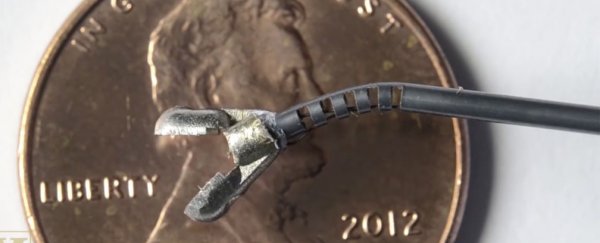"Nobody, not even the rain, has such small hands," is the closing line of one of E. E. Cummings' celebrated poems, but if the poet had lived long enough to see this amazing surgical innovation he might have ended up going with a different metaphor.
Researchers from Vanderbilt University in the US have developed a surgical robot with steerable wrists that will enable physicians to perform more intricate procedures than previously possible when conducting 'needlescopic' surgery.
The prototype's wrists measure only 1.16 mm thick, giving surgeons the ability to manipulate miniature operating tools with more freedom of movement, and theoretically enabling new minimally invasive medical techniques that weren't viable before.
"The smaller you can make surgical instruments the better… as long as you can maintain an adequate degree of dexterity," said Duke Herrell, a surgeon consultant on the project, in a press release. "In my experience, the smaller the instruments, the less post-operative pain patients experience and the faster they recover."
The research, detailed in a paper presented this year at the International Conference on Robotics and Automation in Seattle, uses 'steerable needles': a system of tubes that rotate, extend, and retract, allowing a human operator to control a surgical tip with precision in parts of the body that are so small and delicate there's little or no room for error. One area the researchers believe the device could transform is 'transnasal' surgery, accessing the brain via the nasal cavity (rather than requiring cutting openings through the skull and face).
"Adding the wrists to the steerable needles greatly expands the system's usefulness," Herrell said. "There are a myriad of potential applications in some really exciting areas such as endoscopic neurosurgery, operating within small lumens such as the ear, bronchus, urethra, etc. This would allow us to do surgeries that at present require much larger incisions and may even enable us to perform operations that are not feasible at present."
If you watch the video below you might be surprised at the size of the overall surgical machine. That miniature surgical tip might well be dwarfed by a coin, but it's really just the tip of the iceberg compared to the oversized contraption used to control the wrist. The researchers are patenting the design and hope to see the device available to surgeons within the next five years.

